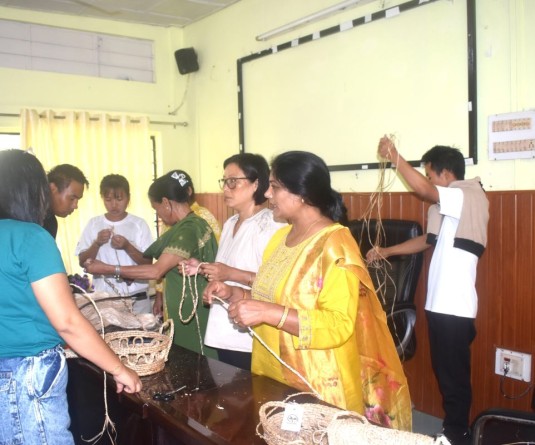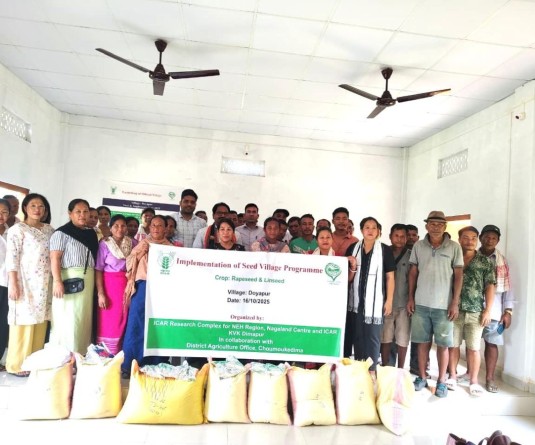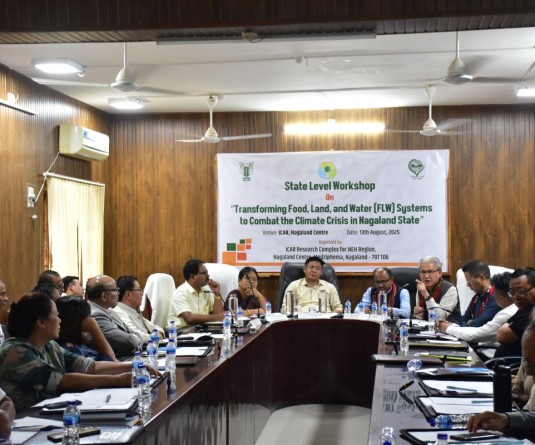
Plant Breeding & Genetics –Harendra Verma
1. Spray Neem Seed Kernel Extract @ 5ml/lit of water for management of insect attack in toria and mustard crop.
2. Arrange the bio-fertilizer and quality seed material of cucumber, okra, sponge gourd, bitter gourd, summer season crops.
3. Apply lime @ 300 kg/ha to maintain the suitable pH of soil.
4. Apply trichoderma @2 kg/ha for management of fungal diseases.
5. Farmer are advocated for green manuring by cultivation of green gram to maintain soil health and organic carbon content.
Fruit Science –Ruth Assumi
1. ASSAM LEMON- Clean the basin of trees. Pruning of branches to be done to activate healthy quality fruiting.
2. ARECANUT– Wherever land is slopping, terracing must be done to prevent soil erosion. Provide manures and fertilizers. It is sensitive to moisture deficit and should only be grown where adequate water facilities are available. Nuts are harvested when they are three quarters ripe.
Plant Pathology- Dr. Mathew S. Baite
1. Weather Monitoring: Stay updated with local weather forecasts to anticipate and manage disease risks effectively.
2. Integrated Dest Management (IDM): Adopt IDM practices, including field sanitation, crop rotation, use of disease-resistant varieties and biological controls, to reduce chemical pesticides and manage diseases sustainably.
Spices, Plantation, Medicinal & Aromatic plants – Azeze Seyie
Blackpepper
1. Harvesting of pepper berries may be done, when one or two berries in a spike turn bright orange to red. Separate the berries (manually or mechanically) from the spikes and dry in the sun for 7-10 days. Dip the berries in hot water for 1-2 minute before drying to get attractive black colour and reduce drying time. Optimum temperature to be maintained in mechanical driers should be around 60oC.
Entomology – Moanaro Lemtur
1. In mustard and Cole crops if aphids infestation is observed, spray soap solution in the initial stage, but if the attack is severe spray Imidacloprid 17.8 SL @ 0.3 ml/L or Novaluron 10 EC @ 1 ml/L of water during evening hours
2. If shoot dropping or bore holes in the fruits are observed in brinjal, first remove all the infested fruit and cut off the dropping shoots and spray NSKE 5% or neem oil @ 2ml/L or Spinosad 45 SC @ 0.75 ml/L of water but if the infestation is severe spray Indoxacarb 14.5 SC or Flubendiamide 39.35% SC @ 0.5 ml/L of water during evening hours.
3. In mango orchard if mango hopper incidence were observed in the previous year, spray Imidacloprid 17.8 SL @ 0.5 ml/L or Novaluron 10 EC @ 1 ml/L to manage during nymph emergence.
4. In litchi plants if mite infestation with velvety growth is observed, remove the infested leaves and spray propargite 57 % EC @ 1.5 ml or or Novaluron 10 EC @ 1 ml/L of water.
Poultry – Mahak Singh and V. Apanai Celina
1. Effective management during winter is essential to ensure the well being and productivity of poultry birds.
2. One of the first considerations for winter management in poultry farming is hanging of gunny bags (at places where cold air enters) to protect the birds from chilled winds.
3. Winter management also requires careful attention to various factors such as-
a. Increased litter depth to serve as an insulator.
b. Increased feed to maintain body temperature.
c. Proper brooding practices for well being and growth of chicks during winter.
Piggery Mahak Singh and Atokali Sumi
1. Ensure that the pig sty’s are properly insulated to maintain comfortable temperature.
2. Adequate feeding is essential to help the pigs maintain its body temperature.
3. Monitor the pig regularly for any signs of illness.
4. Vaccinate the animals against Classical Swine Fever (CSF) for above 2 months old.
5. Maintain proper hygiene in and around the farm.
6. Provide bedding materials such as straw or untreated wood shaving to protect the animals from cold floor.
Fishery – Jyotish Barman
1. If pond water is receding, dewatering of pond and complete harvesting should be done by this pond.
2. After dewatering, remove the pond bottom mud and allow the pond to dry. The excavated mud can be used for strengthening the pond dyke.
3. Expose the pond bottom to bright sun for about 15-20 days till it cracks. Strengthen the pond embankment and carry out minor repairing work during this month.
4. If complete removal of water is not possible, remove the aquatic vegetation manually. Go for repeated netting to remove all small and unwanted fishes, so that the pond can be prepared well for new stocking.
5. If one wants to continue rearing the already stocked fish, then clear all aquatic weeds from the water as well as pond embankment. Aquatic weeds are not desirable as they reduce the living space for fish, consumes essential nutrients required for growth of fish food organisms (phytoplankton, Prevents the entry of sunlight into the pond, utilizes the available dissolved oxygen at night and provides shelter for predatory organisms that prey upon the fish seed.






